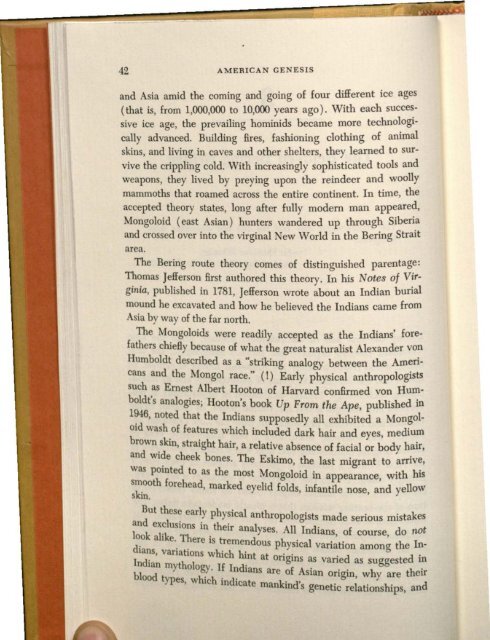You also want an ePaper? Increase the reach of your titles
YUMPU automatically turns print PDFs into web optimized ePapers that Google loves.
42 AMERICAN GENESIS<br />
<strong>and</strong> Asia amid <strong>the</strong> coming <strong>and</strong> going <strong>of</strong> four different ice ages<br />
(that is, from 1,000,000 to 10,000 years ago). With each succ~sive<br />
ice age, <strong>the</strong> prevailing hominids became more technologIcally<br />
advanced. Building fires, fashioning clothing <strong>of</strong> animal<br />
skins, <strong>and</strong> living in caves <strong>and</strong> o<strong>the</strong>r shelters, <strong>the</strong>y learned to survive<br />
<strong>the</strong> crippling cold. With increasingly sophisticated tools <strong>and</strong><br />
weapons, <strong>the</strong>y lived by preying upon <strong>the</strong> reindeer <strong>and</strong> woolly<br />
mammoths that roamed across <strong>the</strong> entire continent. In time, <strong>the</strong><br />
accepted <strong>the</strong>ory states, long after fully modem man appeared,<br />
Mongoloid (east Asian) hunters w<strong>and</strong>ered up through Siberia<br />
<strong>and</strong> crossed over into <strong>the</strong> virginal New World in <strong>the</strong> Bering Strait<br />
area,<br />
<strong>The</strong> Bering route <strong>the</strong>ory comes <strong>of</strong> distinguished parentage:<br />
Thomas Jefferson first authored this <strong>the</strong>ory. In his Notes <strong>of</strong> Virginia,<br />
published in 1781, Jefferson wrote about an <strong>Indian</strong> burial<br />
mound he excavated <strong>and</strong> how he believed <strong>the</strong> <strong>Indian</strong>s came from<br />
Asia by way <strong>of</strong> <strong>the</strong> far north.<br />
<strong>The</strong> Mongoloids were readily accepted as <strong>the</strong> <strong>Indian</strong>s' forefa<strong>the</strong>rs<br />
chiefly because <strong>of</strong> what <strong>the</strong> great naturalist Alex<strong>and</strong>er von<br />
Humboldt described as a "striking analogy between <strong>the</strong> <strong>American</strong>s<br />
<strong>and</strong> <strong>the</strong> Mongol race." (I) Early physical anthropologists<br />
such as Ernest Albert Hooton <strong>of</strong> Harvard confirmed von Humboldt's<br />
analogies; Hooton's book Up From <strong>the</strong> Ape, published in<br />
1946, noted that <strong>the</strong> <strong>Indian</strong>s supposedly all exhibited a Mongoloid<br />
wash <strong>of</strong> features which included dark hair <strong>and</strong> eyes, medium<br />
brown skin, straight hair, a relative absence <strong>of</strong> facial or body bair,<br />
<strong>and</strong> wi~e cheek bones. <strong>The</strong> Eskimo, <strong>the</strong> last migrant to arrive,<br />
was pOinted to as <strong>the</strong> most MongolOid in appearance, with his<br />
smooth forehead, marked eyelid folds infantile nose <strong>and</strong> yellow<br />
skin. I I<br />
But <strong>the</strong>se early phYSical anthropologists made serious mistakes<br />
<strong>and</strong> exclusions in <strong>the</strong>ir analyses. All <strong>Indian</strong>s <strong>of</strong> course do not<br />
look<br />
.<br />
alike. <strong>The</strong>re is t<br />
remen<br />
d<br />
ous p<br />
h'<br />
YSlcal vanahon<br />
.' .<br />
among<br />
'In<br />
<strong>the</strong> -<br />
dlans, variations whi h hi t . . .<br />
I d' c n at ongms as varied as suggested m<br />
n Ian mythology If Indi f' .<br />
bl<br />
. . ans are 0 ASIan origin, why are <strong>the</strong>tr<br />
ood types which' d'<br />
, 10 Icate mankind's genetic relationships, <strong>and</strong>


















